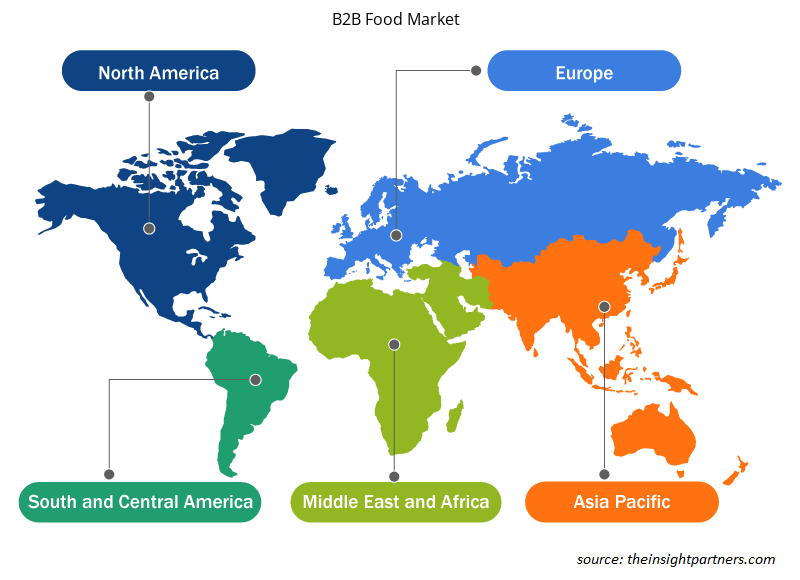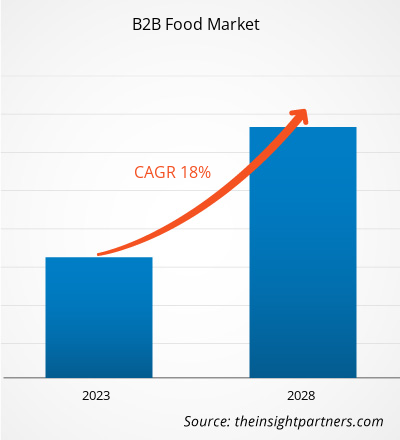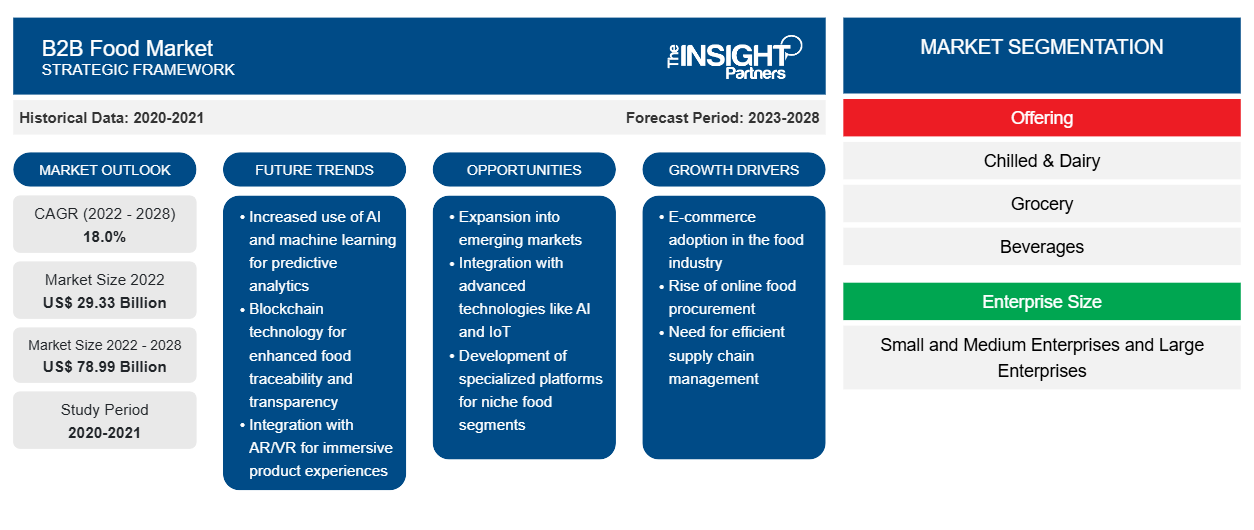Der Markt für B2B-Lebensmittelmarktplatzplattformen soll von 29.326,79 Millionen US-Dollar im Jahr 2022 auf 78.988,62 Millionen US-Dollar im Jahr 2028 wachsen; von 2022 bis 2028 wird mit einer durchschnittlichen jährlichen Wachstumsrate von 18,0 % gerechnet.
B2B-Lebensmittelmarktplatzplattformen verbinden Käufer und Verkäufer auf der ganzen Welt. Die Verkäufer auf diesen Plattformen können Produzenten oder Händler sein, während die Käufer Einzelhändler, Händler und Akteure der Lebensmittelbranche wie Restaurants, Hotels und Kantinen sein können. Diese Plattformen werden für den Handel mit verarbeiteten und unverarbeiteten Lebensmitteln verwendet. Der Markt für B2B-Lebensmittelmarktplatzplattformen erlebt ein erhebliches Wachstum aufgrund der Verbreitung von Smartphones und Tablets, die eine bessere Kommunikation zwischen KMU und Käufern ermöglichen. Darüber hinaus treibt die vertraglich vereinbarte Preisgestaltung der Produkte das Wachstum des Marktes für B2B-Lebensmittelmarktplatzplattformen an. Die zunehmende Akzeptanz verpackter Lebensmittelprodukte, die wachsende Lebensmittelbranche aufgrund steigender verfügbarer Einkommen und der zunehmenden Neigung zu einem modernen Lebensstil sowie die florierende Offshore-Industrie für erneuerbare Energien werden das Wachstum des Marktes für B2B-Lebensmittelmarktplatzplattformen in den kommenden Jahren wahrscheinlich weiter vorantreiben. Die COVID-19-Pandemie hat sich positiv auf das Wachstum des Marktes für B2B-Lebensmittelmarktplatzplattformen ausgewirkt, da sich Käufer und Verkäufer für digitale Lösungen für ihren Geschäftsbetrieb entscheiden.
Zulieferfirmen locken Kunden, indem sie Rabatte oder Sonderangebote auf ihre Produkte oder bei Abnahme einer bestimmten Menge gewähren. Lieferanten und Unternehmen treffen häufig unternehmensweite Preisvereinbarungen, und der Marktpreis eines bestimmten Artikels wird konstant gehalten. Auch im B2B-Lebensmittelsektor wird Preistransparenz gewahrt. Diese Dynamik kommt in der Regel den Lieferanten zugute, die eine Preisdiskriminierungsstrategie basierend auf der Zahlungsfähigkeit und -bereitschaft der Kunden verfolgen können. eFoodChoice.com beispielsweise ist ein B2B-Onlineplattformunternehmen für Lebensmittel, das internationalen Lebensmittelverkäufern und -käufern hilft, ihre Vertriebskanäle zu erweitern, ihr Onlinegeschäft international auszubauen und ihre Rentabilität nachhaltig zu steigern. Abhängig von der Warenmenge bietet das Unternehmen den Käufern eine exklusive Preisspanne. Das Unternehmen hat auch Mindestbestellmengen ( MOQs ) für jede Produktkategorie festgelegt. Mit einer solchen vertraglich vereinbarten Preisgestaltung der Produkte können Endverbraucher die optimale Anzahl an Waren zu einem fairen Preis auswählen, was die Nachfrage nach B2B-Lebensmittelmarktplätzen anregt.
Passen Sie diesen Bericht Ihren Anforderungen an
Sie erhalten kostenlos individuelle Anpassungen an jedem Bericht, einschließlich Teilen dieses Berichts oder einer Analyse auf Länderebene, eines Excel-Datenpakets sowie tolle Angebote und Rabatte für Start-ups und Universitäten.
- Holen Sie sich die wichtigsten Markttrends aus diesem Bericht.Dieses KOSTENLOSE Beispiel umfasst eine Datenanalyse von Markttrends bis hin zu Schätzungen und Prognosen.
Auswirkungen der COVID-19-Pandemie auf den B2B-Marktplatz für Lebensmittelplattformen in Asien-Pazifik
Die COVID-19-Pandemie hat die APAC -Länder aufgrund ihrer hohen Bevölkerungsdichte schwer getroffen , was das Risiko einer Verbreitung von SARS-CoV-2 erhöht hat. Nach Angaben der Organisation für wirtschaftliche Zusammenarbeit und Entwicklung ( OECD ) waren 2020 große Volkswirtschaften wie China, Indien, Australien und Japan von der Pandemie betroffen, die derzeit unter Inflation leiden. Die von den Regierungen der APAC -Länder verhängten Beschränkungen zur Eindämmung der Verbreitung von COVID-19 wirkten sich negativ auf die Lebensmittel- und Getränkeindustrie aus. Die Schließung von Hotels, Restaurants und Cateringunternehmen verringerte die Nutzung von B2B-Lebensmittelmarktplatzplattformen in der Wirtschaft im Asien-Pazifik-Raum, da Online-Lieferungen aufgrund des Lockdowns eingeschränkt waren . Im dritten Quartal 2020 nahmen Hotels, Restaurants und Cateringunternehmen ihren Betrieb jedoch wieder auf und es wird erwartet, dass dieser in den kommenden Jahren wächst. Darüber hinaus wird der zunehmende Tourismus zum Wachstum der Gastronomie in der Region führen, was das Wachstum des Marktes für B2B-Lebensmittelmarktplatzplattformen im Prognosezeitraum weiter ankurbeln wird.
Markteinblicke – B2B-Lebensmittelmarktplatz-Plattformmarkt
Zunehmende Nutzung von E-Commerce-Plattformen steigert Nachfrage nach B2B-Lebensmittelmarktplatzplattformen
Der Anstieg der Online-Käufe ist auf die wachsende Zahl von Online-Händlern und virtuellen Marktplätzen weltweit zurückzuführen. Kleine Unternehmen, C-Stores und E-Commerce-Unternehmen konzentrieren sich zunehmend auf anspruchsvolle Lösungen wie Marktplatzplattformen. Diese Plattformen unterstützen die effiziente und effektive Verwaltung und Kontrolle ihrer Abläufe und Prozesse. Darüber hinaus begünstigen die zunehmende Betonung der Digitalisierung durch stationäre Einzelhändler, Lebensmittelgeschäfte und Start-up-Unternehmen sowie die steigenden Umsätze aus dem Online-Verkauf die Expansion des B2B-Marktplatzplattformmarkts für Lebensmittel in den USA. Der Abbau grenzüberschreitender Handelsbarrieren weltweit bietet Verkäufern und Unternehmen, insbesondere in den USA, erhebliche Möglichkeiten, ihre Produktreichweite international auszuweiten. E-Commerce-Unternehmen, Einkaufszentren und andere Unternehmen wie kleine Läden und Geschäfte wenden sich Online-Marktplätzen zu, um ihre Produkte zu verkaufen, was das Wachstum des B2B-Marktplatzplattformmarkts für Lebensmittel ankurbelt.
Markteinblicke basierend auf Lebensmittelkategorien
Basierend auf der Lebensmittelkategorie ist der Markt für B2B-Lebensmittelmarktplätze in gekühlte Produkte und Milchprodukte, Lebensmittel, Getränke und Sonstiges unterteilt. Das Lebensmittelsegment hatte 2021 den größten Marktanteil. Was die Lebensmittelkategorie betrifft, sind Lebensmittel in allen Teilen der Welt sehr gefragt. Mit der steigenden Bevölkerung ist die Nachfrage danach erheblich gestiegen. Die wachsende Nachfrage nach Reis, Getreide, Mehl und Stärke, Instant-Lebensmitteln und Fertiggerichten treibt den Markt für das Lebensmittelsegment an. Die wachsende junge Bevölkerung und der sich ändernde Lebensstil führen zu einer enormen Nachfrage nach Instant-Lebensmitteln und Fertiggerichten. Dieser Faktor wird voraussichtlich das Wachstum des B2B-Lebensmittelmarktplatzes in den kommenden Jahren ankurbeln. Darüber hinaus wächst auch die Nachfrage nach anderen Lebensmitteln wie Bio-Produkten, Lebensmittelzutaten, Ölen, Nüssen, Kräutern, Saucen, Gewürzen, Samen sowie Süßungsmitteln und Honigprodukten, was zu dem dominierenden Anteil des Segments am B2B-Lebensmittelmarktplatz führt.
B2B Lebensmittel
Regionale Einblicke in den B2B-Marktplatz für Lebensmittel
Die regionalen Trends und Faktoren, die den B2B-Marktplatz für Lebensmittel im Prognosezeitraum beeinflussen, wurden von den Analysten von Insight Partners ausführlich erläutert. In diesem Abschnitt werden auch die Marktsegmente und die Geografie des B2B-Marktplatzes für Lebensmittel in Nordamerika, Europa, im asiatisch-pazifischen Raum, im Nahen Osten und Afrika sowie in Süd- und Mittelamerika erörtert.

- Erhalten Sie regionalspezifische Daten zum B2B-Marktplatz für Lebensmittel
Umfang des Marktberichts zur B2B-Lebensmittelmarktplatzplattform
| Berichtsattribut | Details |
|---|---|
| Marktgröße im Jahr 2022 | 29,33 Milliarden US-Dollar |
| Marktgröße bis 2028 | 78,99 Milliarden US-Dollar |
| Globale CAGR (2022 - 2028) | 18,0 % |
| Historische Daten | 2020-2021 |
| Prognosezeitraum | 2023–2028 |
| Abgedeckte Segmente | Durch das Angebot
|
| Abgedeckte Regionen und Länder | Nordamerika
|
| Marktführer und wichtige Unternehmensprofile |
|
Dichte der Marktteilnehmer auf B2B-Lebensmittelmarktplätzen: Auswirkungen auf die Geschäftsdynamik verstehen
Der Markt für B2B-Lebensmittelmarktplatzplattformen wächst rasant, angetrieben von der steigenden Endverbrauchernachfrage aufgrund von Faktoren wie sich entwickelnden Verbraucherpräferenzen, technologischen Fortschritten und einem größeren Bewusstsein für die Vorteile des Produkts. Mit steigender Nachfrage erweitern Unternehmen ihr Angebot, entwickeln Innovationen, um die Bedürfnisse der Verbraucher zu erfüllen, und nutzen neue Trends, was das Marktwachstum weiter ankurbelt.
Die Marktteilnehmerdichte bezieht sich auf die Verteilung von Firmen oder Unternehmen, die in einem bestimmten Markt oder einer bestimmten Branche tätig sind. Sie gibt an, wie viele Wettbewerber (Marktteilnehmer) in einem bestimmten Marktraum im Verhältnis zu seiner Größe oder seinem gesamten Marktwert präsent sind.
Die wichtigsten Unternehmen, die auf dem Markt für B2B-Lebensmittelmarktplätze tätig sind, sind:
- LebensmittelMaven
- Amazonas
- eFoodChoice.com
- Cheetah Technologies Inc.
- Eworldtrade.com
Haftungsausschluss : Die oben aufgeführten Unternehmen sind nicht in einer bestimmten Reihenfolge aufgeführt.

- Überblick über die wichtigsten Akteure auf dem B2B-Lebensmittelmarktplatz
Die Akteure auf dem Markt für B2B-Lebensmittelmarktplätze konzentrieren sich hauptsächlich auf die Entwicklung fortschrittlicher und effizienter Produkte.
- Im Jahr 2022 schloss Cheetah eine Finanzierungsrunde der Serie C in Höhe von insgesamt 60 Millionen US-Dollar ab und gab den Abschluss von drei Übernahmetransaktionen mit Palo Alto Foods, Esteson und Joseph Martin Foods bekannt.
- Im Jahr 2022 hat Pod Foods Pod Foods Capital auf den Markt gebracht, ein Finanzierungsinstrument, das aufstrebenden Marken einfachen und erschwinglichen Zugang zu Kapital ermöglicht, um das Wachstum ihrer Marke zu unterstützen.
Zu den wichtigsten Akteuren auf dem Markt für B2B-Lebensmittelmarktplatzplattformen gehören FoodMaven, Amazon, eFoodChoice.com, Cheetah technologies Inc., Eworldtrade.com, FoodsTrade, Ufoodin, Pod foods Co., Emerge Srl und Notch.
- Historische Analyse (2 Jahre), Basisjahr, Prognose (7 Jahre) mit CAGR
- PEST- und SWOT-Analyse
- Marktgröße Wert/Volumen – Global, Regional, Land
- Branchen- und Wettbewerbslandschaft
- Excel-Datensatz
Aktuelle Berichte
Verwandte Berichte
Erfahrungsberichte
Grund zum Kauf
- Fundierte Entscheidungsfindung
- Marktdynamik verstehen
- Wettbewerbsanalyse
- Kundeneinblicke
- Marktprognosen
- Risikominimierung
- Strategische Planung
- Investitionsbegründung
- Identifizierung neuer Märkte
- Verbesserung von Marketingstrategien
- Steigerung der Betriebseffizienz
- Anpassung an regulatorische Trends





















 Kostenlose Probe anfordern für - B2B-Marktplatz für Lebensmittel
Kostenlose Probe anfordern für - B2B-Marktplatz für Lebensmittel